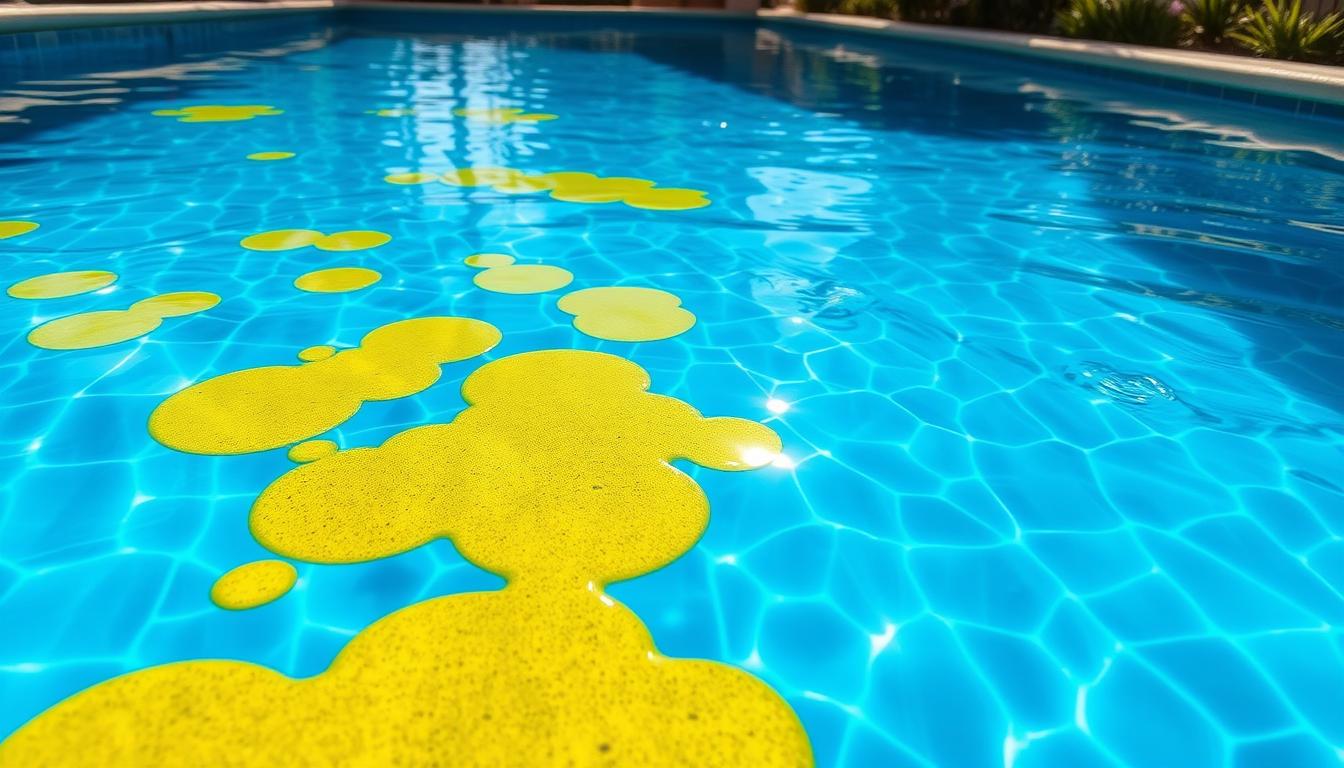
Maintaining a clean pool is crucial for a healthy swimming environment. Sometimes, stubborn mustard algae can invade our pools. This yellowish, chlorine-resistant algae requires specific treatment methods for effective elimination.
Mustard algae, or yellow algae, is a common pool problem worldwide. It forms small, powdery clumps that cling to pool surfaces. This makes mustard algae removal a challenging task.
To prevent its spread, understanding the causes of mustard algae growth is important. Knowing effective strategies to kill mustard algae is also crucial. These steps help maintain a pristine pool.
We’ll explore mustard algae characteristics and factors contributing to its growth. You’ll learn steps to prevent mustard algae infestations. With this knowledge, you can keep your pool algae-free all season long.
Key Takeaways
- Mustard algae is a chlorine-resistant type of algae that can be difficult to remove from pools.
- Proper pool maintenance, including regular testing and cleaning, is essential to prevent mustard algae growth.
- Factors like warm water temperatures and low circulation can contribute to mustard algae outbreaks.
- Effective mustard algae pool treatment involves shocking the pool with high chlorine levels and using specific algaecides.
- Implementing preventive measures, such as maintaining proper water chemistry and hygiene, can help keep mustard algae at bay.
What is Mustard Algae?
Mustard algae is a freshwater algae that causes pool problems. It’s common in warm climates like Texas. This algal bloom can turn pool water a mustard-like color.
Characteristics of Mustard Algae
Mustard algae strongly resists chlorine and other pool sanitizers. It’s tough to remove and often needs repeated treatments. Aggressive shock therapy is usually required to kill all spores.
Mustard algae can arrive at the pool by attaching to pollen or wind-blown debris, making it essential to maintain proper pool hygiene and regular maintenance to prevent its growth.
Unchecked mustard algae can make pools unsafe. It may harbor harmful bacteria like E. coli. It also weakens your pool’s sanitizer, leaving it open to other threats.
Differences Between Mustard and Green Algae
Mustard and green algae both cause pool problems. However, they have some key differences:
| Mustard Algae | Green Algae |
|---|---|
| Chlorine-resistant | Less resistant to chlorine |
| Can grow in shaded areas | Requires sunlight to thrive |
| Less common but harder to eliminate | Most common type found in pools |
Green algae is the most common pool algae. It grows when chlorine is low and circulation is poor. Mustard algae can grow in dark corners and resists treatment better.
What Causes Mustard Algae in Pool?
Mustard algae, or yellow algae, can ruin pool enjoyment. It’s rare in Dallas-Fort Worth but still challenging. Understanding its causes helps with removal and prevention.
Environmental Factors Contributing to Mustard Algae Growth
Several factors can lead to mustard algae in pools. These include nearby rivers with yellow algae and strong breezes carrying spores.
Debris, phosphates, and pollen in pool water also contribute. Shady conditions during hot weather can promote algae growth too.
Environmental factors aren’t the only cause. Poor pool maintenance can also lead to mustard algae problems.
Poor Pool Maintenance and Mustard Algae
Proper pool care is vital in preventing mustard algae growth. Some maintenance issues can lead to mustard algae problems.
| Maintenance Issue | Effect on Mustard Algae Growth |
|---|---|
| Chemical imbalance (pH, alkalinity) | Creates favorable conditions for algae growth |
| Poor water circulation and filtration | Allows algae to thrive and spread |
| Inadequate cleaning of pool surfaces and accessories | Provides a surface for algae to attach and grow |
| Insufficient chlorine levels | Enables algae to multiply rapidly |
To prevent mustard algae, maintain proper water chemistry. Ensure good circulation, perform regular shock treatments, and follow consistent cleaning routines.
Keep pH levels between 7.2-7.4 and alkalinity within 60-120 ppm. Maintain appropriate calcium hardness based on your pool’s material.
The best way to prevent yellow algae from growing in your pool is by organizing regular pool maintenance or pool cleaning.
Understanding these factors helps pool owners prevent mustard algae. Take proactive steps to keep your pool clean and healthy.
Conclusion
Mustard algae can be a stubborn problem in swimming pools. It’s tougher to remove than green or black algae. This yellow algae thrives in shaded areas with warm water temperatures.
Effective removal requires targeted cleaning and proper water care. Regular maintenance is crucial to prevent mustard algae growth. Poor pool upkeep and unbalanced water chemistry can lead to infestations.
Robotic pool cleaners like the Beatbot AquaSense Pro are great for removing mustard algae. They offer energy savings, convenience, and cost-effectiveness. These tools make pool maintenance easier and more efficient.
Successful pool owners use a multi-pronged approach to fight mustard algae. This includes regular water testing and proper chemical balancing. Quick action is key to prevent spread and potential health risks.
Expert advice can provide valuable insights on prevention and treatment. Eco-friendly solutions are becoming popular for combating mustard algae without harming the environment. With vigilance and good strategies, pool owners can ensure a safe swimming experience.







